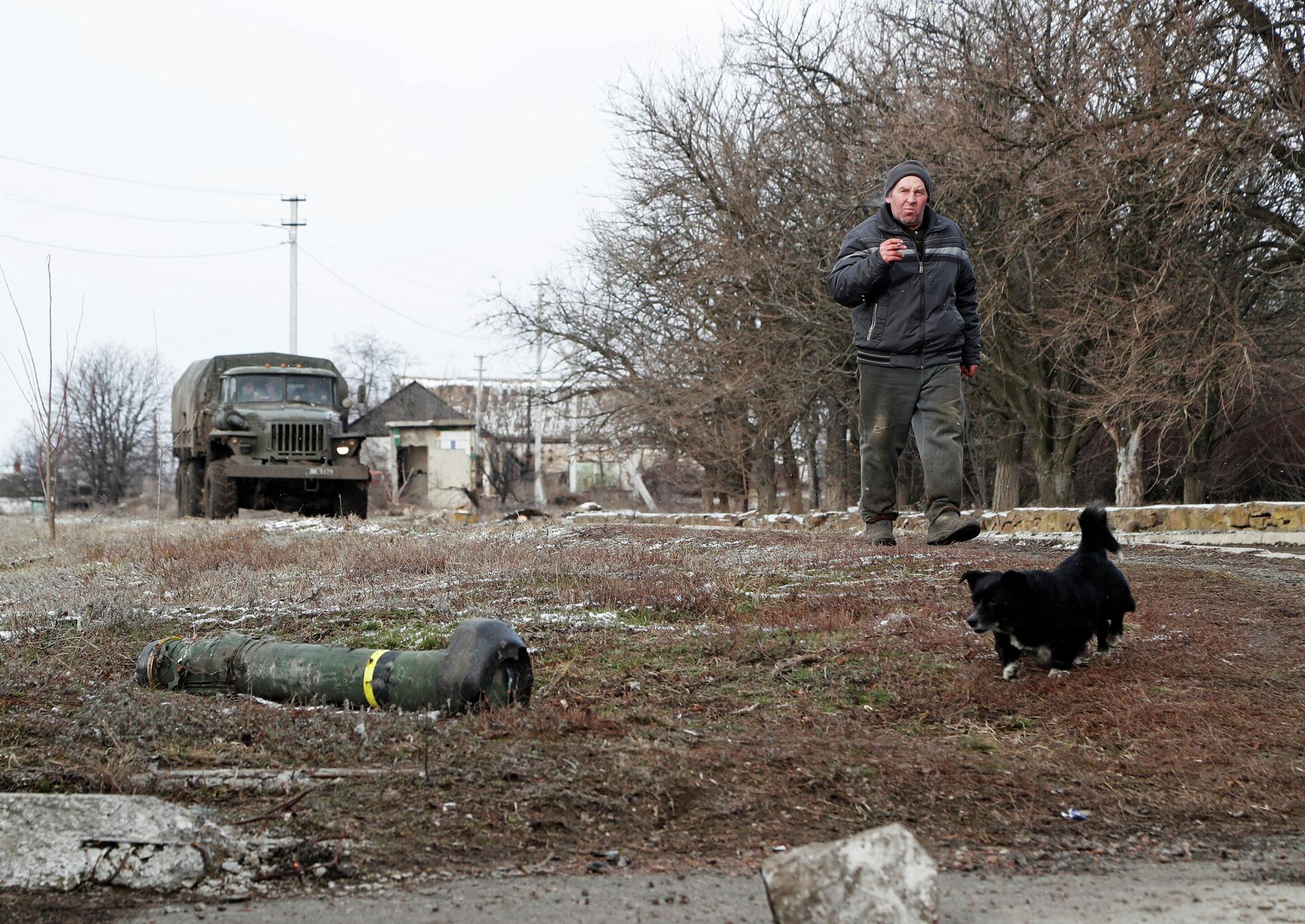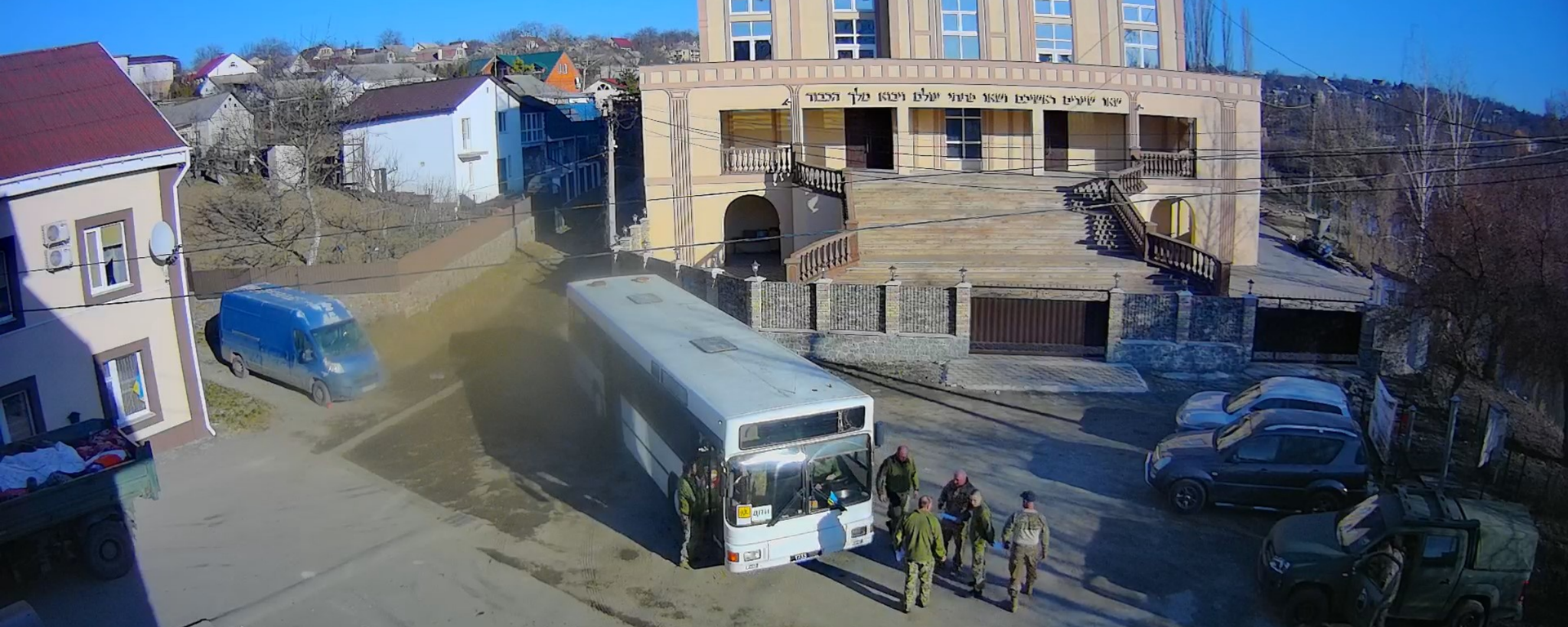https://sputnikglobe.com/20220404/uk-to-go-beyond-military-current-aid-to-ukraine--but-what-has-it-sent-so-far-1094472567.html
UK to 'Go Beyond' Military Current Aid to Ukraine — But What Has it Sent So Far?
UK to 'Go Beyond' Military Current Aid to Ukraine — But What Has it Sent So Far?
Sputnik International
British PM Boris Johnson has used Kiev's newest allegations against Russia to justify stepping up "lethal aid" to Ukraine and its plethora of far-right... 04.04.2022, Sputnik International
2022-04-04T21:32+0000
2022-04-04T21:32+0000
2023-05-28T15:24+0000
russia's special operation in ukraine
ukraine
russia
britain
great britain
boris johnson
arms
dpr
lpr
donbass
https://cdn1.img.sputnikglobe.com/img/07e6/04/04/1094468273_0:0:3071:1728_1920x0_80_0_0_4bdbb81c6bbaaaa2d1bb6e1946625841.jpg
Britain's prime minister has vowed to pump even more arms into Ukraine following Kiev's latest claims of "war crimes".That was after Ukrainian authorities released video footage from the town of Bucha, near Kiev, showing dead bodies strewn around the streets. Kiev claimed the corpses were of local civilians shot by Russian troops before they withdrew from the town to be redeployed to the main front near the breakaway republics in the eastern Donbass region.Russia has refuted that claim, pointing to tell-tale evidence that the "massacre" was a 'false-flag' event stage by Ukrainian forces to whip up support in the West for military intervention against the Russian 'de-Nazification' operation.Johnson is reportedly also considering supplying weapons capable of countering a seaborne assault in or near the southern port city of Odessa by the Russian Navy and Naval Infantry — although the UK does not have any shore-based anti-shipping missiles in its inventory."We have a live list of what they require and we try and meet it where we can," a Downing Street source told the Sunday Times. "The PM is committed to helping Ukraine defend itself and he will support that need."So what is the UK sending to Ukraine as part of its "lethal aid" programme, and does it comply with international arms law?JavelinThe US-made FGM-148 Javelin has been in service since the 1990s, before the invasions and occupations of Afghanistan and Iraq. It was used in both those wars, but mostly not against armored vehicles.Technically, the Javelin is a reloadable launcher for a self-infra red-guided 'fire-and-forget' missile with a high explosive anti-tank (HEAT) shaped-charge warhead. It is easily recognised by its bulky cylindrical black plastic transport case and the hex-nut shaped end caps.The manufacturers claim the FGM-148 can defeat the explosive-reactive armour (ERA) blocks fitted to Russian tanks, and then penetrate 60 cm of armour plate. But there have already been several reports from Ukraine of Russian tanks — whose composite frontal armour protection is equivalent to a metre of steel plate — taking multiple Javelin hits and fighting on regardless.Another criticism of the system is that it is too unwieldy for infantry. The ready-to-fire weight of the 1.2-metre long launch tube and the missile is 22 kg — like carrying a suitcase loaded up to the airline baggage limit on your shoulder.The Pentagon reportedly plans to buy just 586 of the $250,000 Javelin missiles from makers Raytheon and Lockheed Martin this year, down from 866 in 2021, despite having sent more than 4,600 of them to Ukraine.NLAWDesigned by prestigious Swedish defence conglomerate Saab Bofors Dynamics, the next generation Light Anti-tank Weapon (NLAW) is a disposable anti-tank rocket launcher with a simple guidance system that predicts a moving target's path based on the gunner.Weighing in at 12.5 kg, the NLAW is just over half the weight of the ponderous Javelin missile, while boasting almost as much armour-piercing ability on paper. It's also one-eighth the cost of the bigger missile, according to some defence sources.It has a top-attack mode, using a magnetic sensor to detonate the warhead directly over the target. But with Russian tanks now mounting ERA on the turret roof, its effectiveness is questionable.Britain began sending hundreds of NLAWs to Ukraine even before the conflict began, drawing protests from Moscow that they would be used along the Line of Control between the Donetsk and Lugansk People's Republics and Ukrainian forces. Defence Secretary Ben Wallace claimed the weapons were purely defensive, citing their limited range of 800 metres (half a mile) — compared to 4 km (2.5 miles) for the Javelin.Ironically, numerous NLAWs and Javelins have fallen into the hands of the Donbass republic militias since the military operation began, to be used against their former owners.StarstreakAnother much-vaunted weapon London claims to be gifting Kiev is the Starstreak shoulder-launched surface-to-air missile (SAM). However, little or no evidence of its deployment on the front line in Ukraine has yet come to light.The Starstreak claimed to totally outclass other man-portable air defence systems (MANPADS) in terms of speed, accelerating to up to Mach 4.Rather than a single fragmenting warhead with a proximity fuse, it releases three submunition explosive-filled darts which are independently guided to the target.And instead of an infra-red seeker head or semi-active radar homing, it uses a laser-based targeting system with missiles 'beam-riding' to the target. While that makes radar jamming and dropping incendiary flare decoys useless against the Starstreak, it means the user must track the target continuously, making hits less likely against fast-moving aircraft or if the target flies into a cloud.But like many other MANPADS, its maximum engagement range and height are limited, to 7 km (4.4 miles) distance and 5 km (16,000 feet) altitude. With Russia maintaining air superiority and most of the Ukrainian army's higher-altitude SAMs already destroyed, fixed-wing jets can simply fly too high for MANPADS to reach them, while the guided missiles carried by Russian attack helicopters have a slight edge in range.International LawExporting arms to a country already at war raises some ethical quandaries. Sweden refused to sell arms to the US after it formally entered the Vietnam War in 1965, while the US cut off arms deliveries to Argentina during the 1982 Falklands War.The UK, however, has been a full party to the international Arms Trade Treaty (ATT) since December 2014. The ATT prohibits the export or transit of weapons if it is known they "would be used in the commission of genocide, crimes against humanity, grave breaches of the Geneva Conventions of 1949, attacks directed against civilian objects or civilians protected as such, or other war crimes."Moscow has consistently warned that arms sent to the Ukrainian military — into which neo-Nazi groups such as the Azov and Aidar battalions and the Right Sector have been merged — would inevitably end up in the hands of extreme-right militants across Europe.The proliferation of MANPADS since the 1970s — largely thanks to the USA's proxy wars and covert arms deals — has raised fears that terrorist organisations could use them to shoot down civilian airliners just after take-off.Ukrainian Army and National Guard troops have been accused — and even boasted — of abusing Russian prisoners of war, shooting them in the knees and hips in gross violation of the Geneva Conventions on the treatment of captives.Human rights abuses have also been reported. Civilian militants, armed and drafted into the Territorial Defence Forces, have been rounding up members of the Roma ethnic community, taping them to lamp-posts and spraying their faces with green paint.And survivors of the neo-Nazi battalion' torture chambers at the recently-captured Mariupol airport have given accounts of their ordeals.
https://sputnikglobe.com/20220330/synagogue-in-ukraines-uman-was-used-to-house-nazis-their-weapons-says-russian-defense-ministry-1094315701.html
ukraine
russia
britain
great britain
donbass
united kingdom (uk)
Sputnik International
feedback@sputniknews.com
+74956456601
MIA „Rosiya Segodnya“
2022
James Tweedie
https://cdn1.img.sputnikglobe.com/img/07e4/08/1c/1080307270_0:3:397:400_100x100_80_0_0_7777393b9b18802f2e3c5eaa9cbcc612.png
James Tweedie
https://cdn1.img.sputnikglobe.com/img/07e4/08/1c/1080307270_0:3:397:400_100x100_80_0_0_7777393b9b18802f2e3c5eaa9cbcc612.png
News
en_EN
Sputnik International
feedback@sputniknews.com
+74956456601
MIA „Rosiya Segodnya“
Sputnik International
feedback@sputniknews.com
+74956456601
MIA „Rosiya Segodnya“
James Tweedie
https://cdn1.img.sputnikglobe.com/img/07e4/08/1c/1080307270_0:3:397:400_100x100_80_0_0_7777393b9b18802f2e3c5eaa9cbcc612.png
ukraine, russia, britain, great britain, boris johnson, arms, dpr, lpr, donbass, united kingdom (uk)
ukraine, russia, britain, great britain, boris johnson, arms, dpr, lpr, donbass, united kingdom (uk)
UK to 'Go Beyond' Military Current Aid to Ukraine — But What Has it Sent So Far?
21:32 GMT 04.04.2022 (Updated: 15:24 GMT 28.05.2023) British PM Boris Johnson has used Kiev's newest allegations against Russia to justify stepping up "lethal aid" to Ukraine and its plethora of far-right militant groups. But what weapons is the UK sending, and is the policy in line with its international legal obligations?
Britain's prime minister has vowed to pump even more arms into Ukraine following Kiev's latest claims of "war crimes".
NATO has a "responsibility to give them everything they need to face down this barbaric attempt to subjugate the Ukrainian people," Boris Johnson said on Monday, the 73rd anniversary of the Western military bloc.
That was after Ukrainian authorities released video footage from the town of Bucha, near Kiev, showing dead bodies strewn around the streets.
Kiev claimed the corpses were of local civilians shot by Russian troops before they withdrew from the town to be redeployed to the main front near the breakaway republics in the eastern Donbass region.
Russia has refuted that claim, pointing to tell-tale evidence that the "massacre" was a 'false-flag' event stage by Ukrainian forces to whip up support in the West for military intervention against the Russian 'de-Nazification' operation.
Johnson is reportedly also considering supplying weapons capable of countering a seaborne assault in or near the southern port city of Odessa by the Russian Navy and Naval Infantry — although the UK does not have any shore-based anti-shipping missiles in its inventory.
"We have a live list of what they require and we try and meet it where we can," a Downing Street source told the
Sunday Times. "The PM is committed to helping Ukraine defend itself and he will support that need."
So what is the UK sending to Ukraine as part of its "lethal aid" programme, and does it comply with international arms law?
The US-made FGM-148 Javelin has been in service since the 1990s, before the invasions and occupations of Afghanistan and Iraq. It was used in both those wars, but mostly not against armored vehicles.
Technically, the Javelin is a reloadable launcher for a self-infra red-guided 'fire-and-forget' missile with a high explosive anti-tank (HEAT) shaped-charge warhead. It is easily recognised by its bulky cylindrical black plastic transport case and the hex-nut shaped end caps.
The manufacturers claim the FGM-148 can defeat the explosive-reactive armour (ERA) blocks fitted to Russian tanks, and then penetrate 60 cm of armour plate.
But there have already been several reports from Ukraine of Russian tanks — whose composite frontal armour protection is equivalent to a metre of steel plate — taking multiple Javelin hits and fighting on regardless.
Another criticism of the system is that it is too unwieldy for infantry. The ready-to-fire weight of the 1.2-metre long launch tube and the missile is 22 kg — like carrying a suitcase loaded up to the airline baggage limit on your shoulder.
The Pentagon
reportedly plans to buy just 586 of the $250,000 Javelin missiles from makers Raytheon and Lockheed Martin this year, down from 866 in 2021, despite having sent more than 4,600 of them to Ukraine.
Designed by prestigious Swedish defence conglomerate Saab Bofors Dynamics, the next generation Light Anti-tank Weapon (NLAW) is a disposable anti-tank rocket launcher with a simple guidance system that predicts a moving target's path based on the gunner.
Weighing in at 12.5 kg, the NLAW is just over half the weight of the ponderous Javelin missile, while boasting almost as much armour-piercing ability on paper. It's also one-eighth the cost of the bigger missile, according to some defence sources.
It has a top-attack mode, using a magnetic sensor to detonate the warhead directly over the target. But with Russian tanks now mounting ERA on the turret roof, its effectiveness is questionable.
Britain began sending hundreds of NLAWs to Ukraine even before the conflict began, drawing protests from Moscow that they would be used along the Line of Control between the Donetsk and Lugansk People's Republics and Ukrainian forces. Defence Secretary Ben Wallace claimed the weapons were purely defensive, citing their limited range of 800 metres (half a mile) — compared to 4 km (2.5 miles) for the Javelin.
Ironically, numerous NLAWs and Javelins have fallen into the hands of the Donbass republic militias since the military operation began, to be used against their former owners.
Another much-vaunted weapon London claims to be gifting Kiev is the Starstreak shoulder-launched surface-to-air missile (SAM). However, little or no evidence of its deployment on the front line in Ukraine has yet come to light.
The Starstreak claimed to totally outclass other man-portable air defence systems (MANPADS) in terms of speed, accelerating to up to Mach 4.
Rather than a single fragmenting warhead with a proximity fuse, it releases three submunition explosive-filled darts which are independently guided to the target.
And instead of an infra-red seeker head or semi-active radar homing, it uses a laser-based targeting system with missiles 'beam-riding' to the target. While that makes radar jamming and dropping incendiary flare decoys useless against the Starstreak, it means the user must track the target continuously, making hits less likely against fast-moving aircraft or if the target flies into a cloud.
But like many other MANPADS, its maximum engagement range and height are limited, to 7 km (4.4 miles) distance and 5 km (16,000 feet) altitude. With Russia maintaining air superiority and most of the Ukrainian army's higher-altitude SAMs already destroyed, fixed-wing jets can simply fly too high for MANPADS to reach them, while the guided missiles carried by Russian attack helicopters have a slight edge in range.
Exporting arms to a country already at war raises some ethical quandaries. Sweden refused to sell arms to the US after it formally entered the Vietnam War in 1965, while the US cut off arms deliveries to Argentina during the 1982 Falklands War.
The UK, however, has been a full party to the international
Arms Trade Treaty (ATT) since December 2014.
The ATT prohibits the export or transit of weapons if it is known they "would be used in the commission of genocide, crimes against humanity, grave breaches of the Geneva Conventions of 1949, attacks directed against civilian objects or civilians protected as such, or other war crimes."
Moscow has consistently warned that arms sent to the Ukrainian military — into which neo-Nazi groups such as the Azov and Aidar battalions and the Right Sector have been merged — would inevitably end up in the hands of extreme-right militants across Europe.
The proliferation of MANPADS since the 1970s — largely thanks to the USA's proxy wars and covert arms deals — has raised fears that terrorist organisations could use them to shoot down civilian airliners just after take-off.
Ukrainian Army and National Guard troops have been accused — and even boasted — of abusing Russian
prisoners of war, shooting them in the knees and hips in gross violation of the Geneva Conventions on the treatment of captives.
Human rights abuses have also been reported. Civilian militants, armed and drafted into the Territorial Defence Forces, have been rounding up members of the Roma ethnic community, taping them to lamp-posts and spraying their faces with green paint.
And survivors of the neo-Nazi battalion' torture chambers at the recently-captured Mariupol airport have
given accounts of their ordeals.







